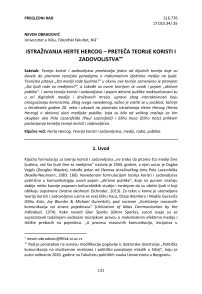Istraživanja Herte Hercog – preteča teorije koristi i zadovoljstva
Автор: Neven Obradović
Журнал: Sport Mediji i Biznis @journal-smb
Статья в выпуске: 1 vol.8, 2022 года.
Бесплатный доступ
Teorija koristi i zadovoljstva predstavlja jednu od ključnih teorija koje su dovele do promene teorijske paradigme o maksimalnim efektima medija na ljude. Teorijsko pitanje „šta mediji rade ljudima?” u okviru ove teorije zamenjeno je pitanjem „šta ljudi rade sa medijima?”, a takođe sa ovom teorijom se uvodi i pojam „aktivne publike”. I sama teorija koristi i zadovoljstva i pojam aktivne publike reaktuelizovani su u eri digitalnih medija i društvenih mreža, upravo zbog interaktivnosti koju omogućavaju korisnicima. Zbog svega navedenog, važno je vratiti se u prošlost, tačnije u četrdesete godine 20. veka i ukazati na pionirska istraživanja Herte Hercog (Herta Herzog) o aktivnoj ulozi medijske publike, koja su bila od velikog značaja za tim okupljen oko Pola Lazarsfelda (Paul Lazarsfeld) i Elihu Kaca (Elihu Katz) prilikom postavljanja temelja teorije koristi i zadovoljstva.
Herta Hercog, Teorija koristi i zadovoljstva, mediji, radio, publika
Короткий адрес: https://sciup.org/170203627
IDR: 170203627 | УДК: 316.776; 17.023.34/.35 | DOI: 10.58984/smb2201131o
Список литературы Istraživanja Herte Hercog – preteča teorije koristi i zadovoljstva
- Baran, S., & Davis, D. (2010). Mass communication theory: Foundations, ferment, and future, sixth edition. Boston: Cengage Learning.
- Curran, J., Gurevitch, M., & Woollacott, J. (2005). The study of the media: Theoretical approaches. In: M. Gurevitch, T. Bennett, J. Curran & J. Woollacott, Culture, society and the media. Taylor & Francis e-Library, 6–25.
- Fiske, J. (2001). Television Culture: Popular Pleasures and Politics. Taylor & Francis eLibrary.
- Herzog, H. (1940). Professor quiz: A gratification study. In: P. F. Lazarsfeld (Ed.), Radio and the printed page; an introduction to the study of radio and its role in the communication of ideas. New York: Duell, Sloan, & Pearce, 64–93.
- Herzog, H. (1944). What do we really know about daytime serial listeners. Radio research, 1943, 3–33.
- Hoerschelmann, O. (2006). Rules of the game: Quiz shows and American culture. Albany: SUNY Press.
- Lin, C. A. (1996). Standpoint: Looking back: The contribution of Blumler and Katz's uses of mass communication to communication research. Journal of Broadcasting & Electronic Media, 40, 574–581.
- Merriam-Webster dictionary. Panglossian. URL: https://www.merriamwebster.com/dictionary/Panglossian. Posećeno: 24.08.2022.
- Milivojević, S. (2001). Javnost i ideološki efekti medija. Reč – Časopis za književnost i kulturu i društvena pitanja, 64/10. URL: http://www.fabrikaknjiga.co.rs/knjige/casopis-rec/page/2/.
- Noelle‐Neumann, E. (1983). The effect of media on media effects research. Journal of communication, 33(3), 157–165.
- Papacharissi, Z. (2009). Uses and Gratifications. In: D. W. Stacks and M. B. Salwen (Eds.), An Integrated Approach to Communication Theory and Research. New York: Routledge, 137–152.
- Pepitone, A. (1957). Book Review Personal Influence: The Part Played by People in the Flow of Mass Communication (Book authors: E. Katz, P. F. Lazarsfeld & E. Roper). The American Journal of Psychology, 70(1), 157–158.
- Rubin, A. M. (2009). Uses-and-gratifications perspective on media effects. In: J. Bryant & M. B. Oliver (Eds.), Media effects – Advances in Theory and Research. New York: Routledge, 165–184.
- Ruggiero, T. E. (2000). Uses and gratifications theory in the 21st century. Mass communication & society, 3(1), 3–37.
- Schroder, K. C. (2013). Socio-cultural models of communication. In: P. Cobley & P. J. Schulz (Eds.), Theories and models of communication, volume 1. Berlin: De Gruyter Mouton, 327–347.
- Simonson, P. (2012). The rise and fall of the limited effects model. In: A. N. Valdivia (General Editor), The International Encyclopedia of Media Studies, Volume I: Media History and the Foundations of Media Studies (Edited by John Nerone). Oxford: Blackwell Publishing.
- Sparks, G. (2012). Uses and Gratifications of Elihu Katz. In: E. Griffin (Ed.), A first look at communication theory. New York: McGraw-Hill, 357–365.
- Vreg, F. (1991). Demokratsko komuniciranje: prilog pluralističkoj paradigmi u komunikacijskoj nauci. Sarajevo: Narodna i univerzitetska biblioteka BiH Sarajevo.


